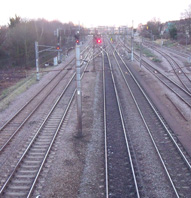UK railways have set out its plans for the future of the rail sector, including completion of major projects, clean air policies and a long-term plan for infrastructure renewals and enhancements. With more investment and commitment predicted for the industry, Andy Hewitt, Product Manager for ASSA ABLOY High Security and Safety Group, Rail Products, looks at what is needed to supply the best products and solutions for rail projects.
As a Group we have been supplying security and safety solutions to the rail sector for over 100 years and as such we’re aware of the many complexities involved specifying products for rail projects, which are very different to securing a building. Considerations around ease of use, product quality and wider issues around supplying on-scale and on-time all impact on a project’s delivery, but ultimately safety and security must be the key consideration.
Safety
Any locking systems or safety products supplied to the railway industry are classed as ‘safety critical’ items and therefore must conform to specific Rail Standards for Safety Critical Items. In addition, the company supplying these products must be accredited as a safety critical supplier by an independent body. ASSA ABLOY High Security and Safety Group (previously Pickersgill – Kaye) was one of the first companies to be accredited back in 1994 and has remained an accredited supplier ever since.
Products supplied for use on rolling stock is by, its very nature safety critical, securing doors that are used daily by the rail users must operate reliably and safely. ASSA ABLOY products are not only supported by the requirements of industry standards but are also backed up by years of experience gained working within the industry and having a detailed knowledge of changes to legislation put in place to protect the public and rail staff.
Product development
The security, access and safety needs on the UK’s railways is constantly changing and therefore products and solutions must continually adapt to meet these needs. Locking systems in particular are subject to high usage and the dynamics of a moving train, shock and vibration at speeds of up to 140mph, this must be taken into consideration when designing products for this sector. An example of how this has developed is in the change from traditional slam door trains where the door could be, and sometimes was, opened when the train was moving at speed, to the replacement of all slam doors with power operated doors. These doors cannot be opened unless the train is stationary and only then when the guard or driver allows.
Another development High Security and Safety Group has been working on is the enhanced safety of Diesel Locomotive driver doors, where previously fingers being trapped was a concern, the new design has significantly reduced this. The Group has designed, manufactured and fitted a prototype locking system that drastically reduces the chances of fingers becoming trapped. The prototype is now in-service undergoing assessment, not only by train drivers, but by the locomotive operators’ safety representatives and the train drivers’ unions.
Investment is continuing into the UK railway network, whether that’s on large-scale projects like HS2 or enhancements to existing systems. The products and solutions which ensure the safety and security on these projects, must not only adhere to the relevant safety requirements but should come from suppliers with an established heritage and understanding of the sector.
Visit www.assaabloyopeningsolutions.co.uk.










